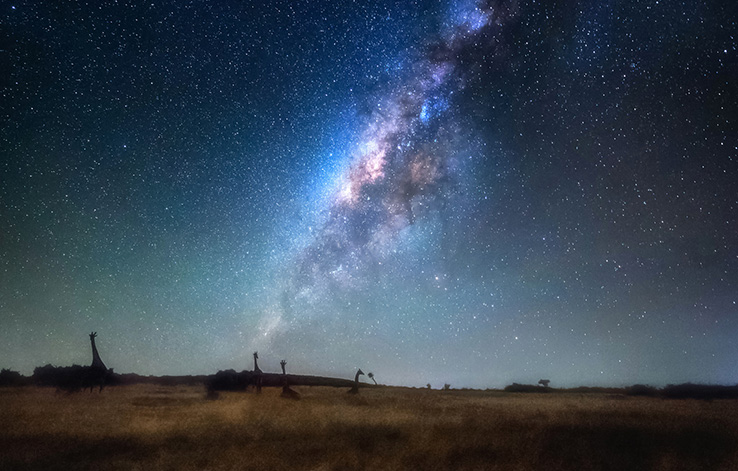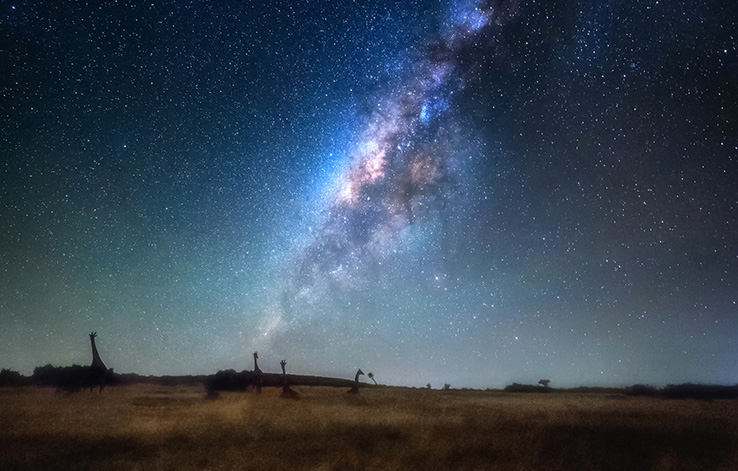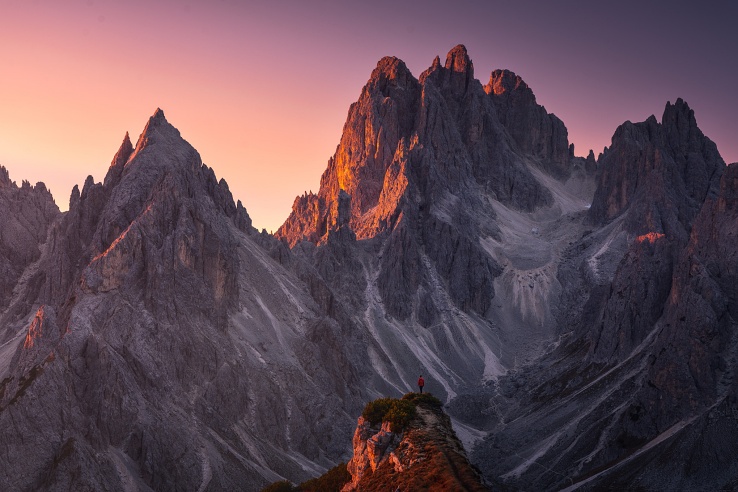The PhotoPills Expedition to Namibia is Sold Out (Join the Waiting List)
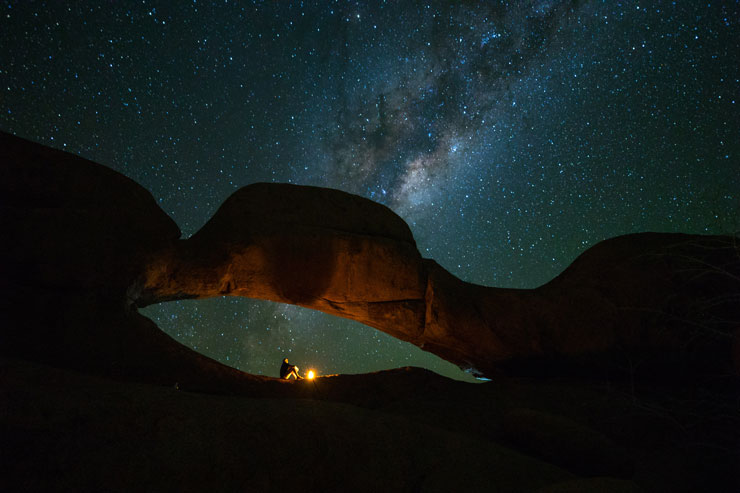
The PhotoPills Expedition to Namibia is SOLD OUT!
Wow!
All 14 spots are already gone!
Thanks so much :D
Wish to join us?
Don't give up!
Click here to join the Waiting List.
Be the first one to know when a cancellation occurs.
PhotoPillers in Namibia...
Are you in?
Around the New Moon...
From April 24th to May 10th 2022, Jandré Germishuizen (local PhotoPills Master) and Rafael Pons (the Bard of the PhotoPills team) will travel across Namibia to photograph the Milky Way and the golden light along with impressive rock formations, giant red dunes, dead trees, the diverse wildlife and the Himba.
In one of the darkest skies on the planet!
Of course…
We’ll be taking photos all day long...
But...
Can you imagine it?
To photograph the Milky Way and the golden light with iconic mountains, rare rock formations, immense red-sand dunes, isolated dead trees, millenary living plants, elephants, lions, zebras, giraffes and the Himba tribe.
We’re dreaming about it!
To achieve it, we’ll use the planning power of PhotoPills and the expert knowledge of Jandré Germishuizen to always be at the right place at the right time.
Top secret: we have quite a few legendary photos planned already ;)
The deal (only 14 spots)
Since you subscribed to the Priority Access list...
We're offering you a €500 discount on the regular price!
All you have to do is to book 1 of the 14 spots available before Sunday November 7th.
Read carefully all the details of this unique adventure.
And when you’re ready, fill in the booking form.
Please, book as soon as possible. The seats are sold on a first come, first served basis.
The adventure
14 PhotoPillers | Jandré Germishuizen | Namibia | Endless legendary photos
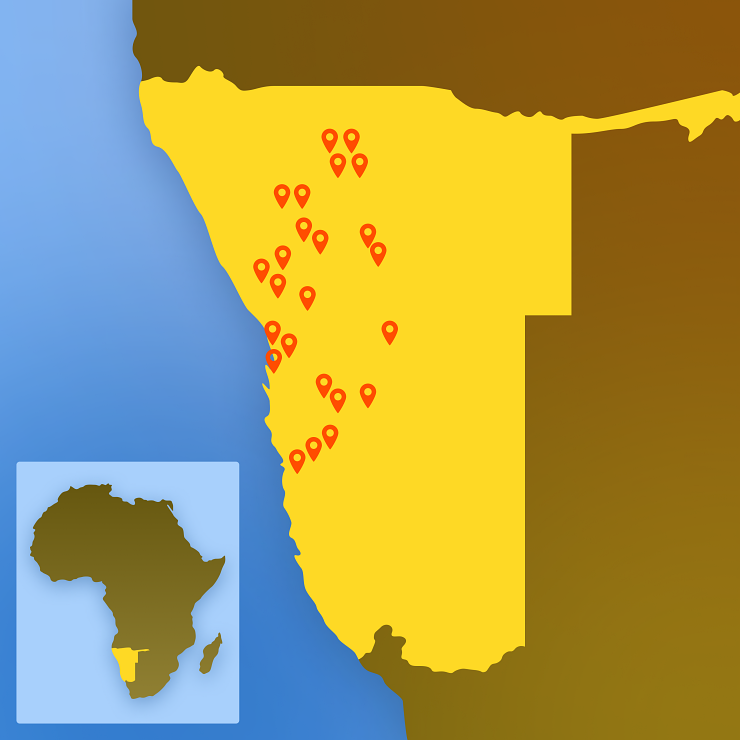
Warning: This is not a honeymoon. In Africa, we’ll sleep under the stars!
We’re recruiting 14 brave PhotoPillers (PhotoPills and photography freaks) that will join us on a 17-day expedition to photograph the Milky Way along the Namibia treasures.
It’s a non-stop self-drive safari to chase legendary pictures and you are a key asset!
Would you like to drive? Awesome... Because we need you!
We have planned tons of photos, and we’ll travel thousands of kilometers to capture them...
But we also want to maximize our flexibility in terms of itinerary and schedule in order to take advantage of all the opportunities that will surely come our way.
If we come across a herd of lionesses hunting or we spot a group of elephants, we’ll make a halt and take advantage of the occasion.
When we are hungry, we’ll stop and eat. When we are tired, we’ll stop and rest (cold beer included)...
This means that we’ll travel in 4x4 vehicles fully equipped with water, food, camping equipment and tents. Those of you who don’t sleep in the individual tents on the vehicles will do it with us, in tents planted at ground level (and you won’t have to pitch the tents if you do not feel like it, we’ll pitch them for you).
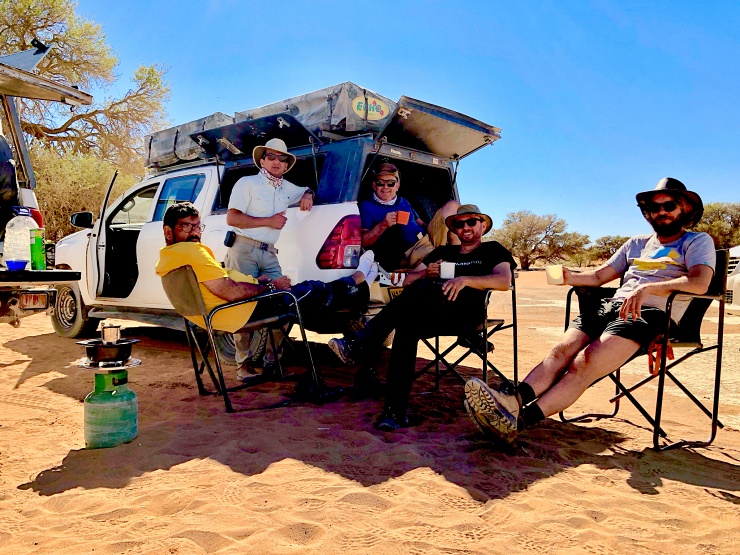
Oh!
And do not worry about the sleeping bag and other camping equipment. The vehicles are equipped with everything we’ll need to survive in the desert :)
You are about to embark on a journey following the PhotoPills style. And it’s going to be far from a honeymoon... :P
This adventure is going to require a lot of physical effort... But it's going to be so fun!
Are you in?
Day 1. Sunday, April 24th - Welcome to Namibia!
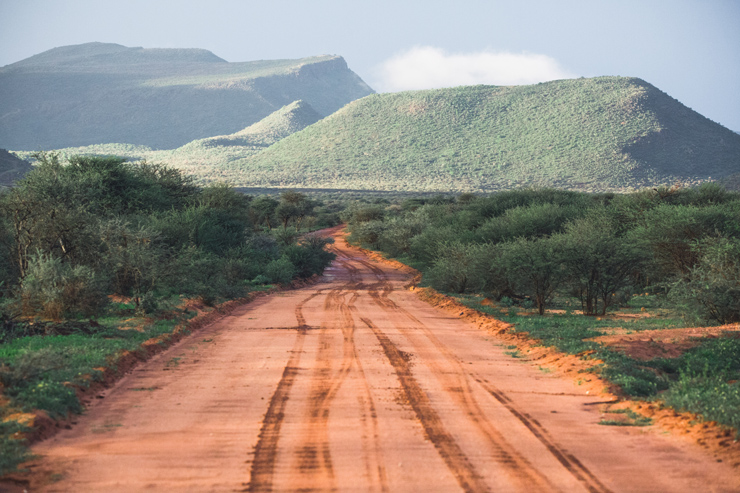
It’s Sunday morning when you land at Hosea Kutako International Airport, the main airport of Namibia, located 45 km (25 mi) from the capital, Windhoek.
There, Jandré and Rafael welcome you. You can’t miss them: they’re wearing the yellow PhotoPills t-shirt.
Once the whole group of expeditioners is ready, we’ll pick up our 4x4 vehicles (have your driving license ready) and we’ll begin our journey towards the capital.
On this first night, we will sleep at Windhoek Luxury Suits. With its lush green gardens and lavish designer rooms, it offers luxury and tranquillity in the heart of the city.
2:00 pm
After checking in at the hotel, we’ll enjoy the fresh and diverse flavors of Namibia at Stellenbosch, a beautiful wine bar and bistró.
4:00 pm
Either enjoy a long nap (siesta) or relax by the pool, both are good options to recover from all the travels.
6:00 pm
A hat, sun cream, lip balm, anti mosquito spray... There is always something you forgot to bring from home. And there is always one last thing to buy before a long expedition. So we’ll take a few cars and go shopping.
8:00 pm
You find yourself in a taxi.
Did you hear it? That sound inside? Our stomachs are roaring.
Because tonight we’ll have dinner at our favorite restaurant in Namibia – the always inspiring Joe’s Beer House, which happens to be just a few minutes from our hotel. So cool!
We’ll step inside Joe’s to feel, taste and see Namibia… And forget everything and everywhere else.
11:00 pm
It’s been a long day. I bet you can’t wait to go to bed. Enjoy a good and well deserved sleep.
Tomorrow the Namib desert awaits.
Day 2. Monday, April 25th - The Sossusvlei dunes red sea
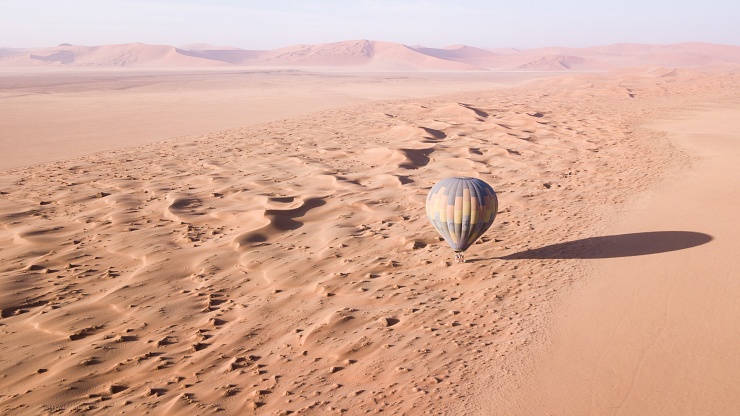
8:00 am
After a hearty breakfast, we’ll jump onto our vehicles and drive towards the west. We’re going to Sossusvlei, our next destination.
Located in the heart of the Namib-Naukluft National Park, Sossusvlei enjoys some of the highest dunes in the world, reaching almost 400 m (1300 ft).
These huge dunes are red because the iron in the sand is oxidized. They are covered with small vegetation that hydrates with the Atlantic breezes, creating some little ochre, red and blue tints.
We’ll stop along the way to take our first photos of the arid landscapes of Namibia. And around noon, we’ll stop for lunch in a beautiful place.
2:00 pm
We’ll check-in at Sesriem Oshana Campsite, just outside the main gate that leads into Sossusvlei.
After a short briefing of the afternoon plan, we’ll go scouting. Our goal is to find an isolated dead tree near the camp, and use the PhotoPills’ Night Augmented Reality tool to plan a cool Milky Way photo for tonight.
3:30 pm
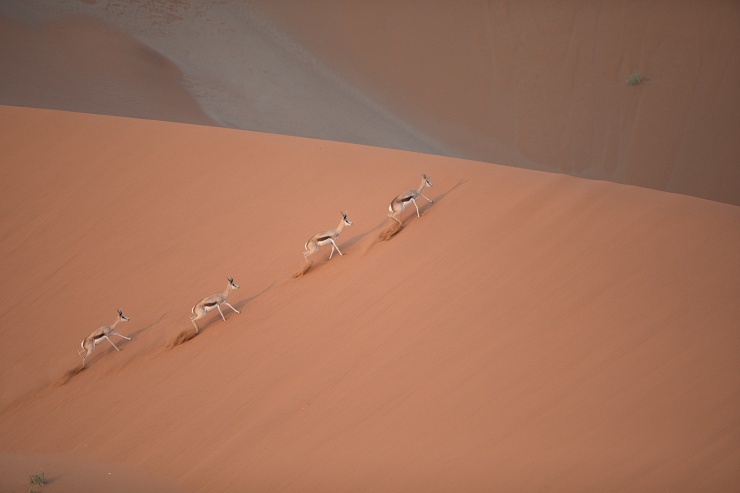
Sossusvlei hides many treasures, and we want to explore and photograph them all.
There are a few hours left before the park closes. The access gate opens at Sunrise and closes at Sunset.
So get ready, because we’re driving along a narrow path towards the immense dunes.
Among the many dunes to photograph, there are two that are simply spectacular: Dune 35 and Dune 40.
Open PhotoPills to check that...
Golden hour begins at 6:03 pm, Sunset is at 6:34 pm, blue hour begins at 6:48 pm and blue hour ends at 6:57 pm.
7:00 pm
Time to set up the camp, take a shower and get ready for dinner.
When camping during our expedition, we’ll have a team of Camp Masters that will cook for us. So once we get to the camp, the table and food will always be ready.
9:00 pm

Remember the tree we found in the afternoon? Well, we’re now walking towards it. Because the Milky Way will be in place very soon, just as you planned it.
We’re in the southern hemisphere, the Milky Way core looks huge above our heads. What a show!
The astronomical twilight begins at 7:24 pm and the Galactic Center is visible from 9:29 pm until 5:59 am. The waning crescent Moon (32.7%) rises at 2:04 am.
12:00 am
Time to go to bed. Tomorrow we’ll get up very early to reach the mystic Deadvlei at Sunrise.
Photographic Pills:
- Sossusvlei red sea of dunes.
- Dunes 35 and 40.
- Desert wildlife.
- Golden hour in the desert.
- Milky Way and the dead tree.
Day 3. Tuesday, April 26th - The dead forest
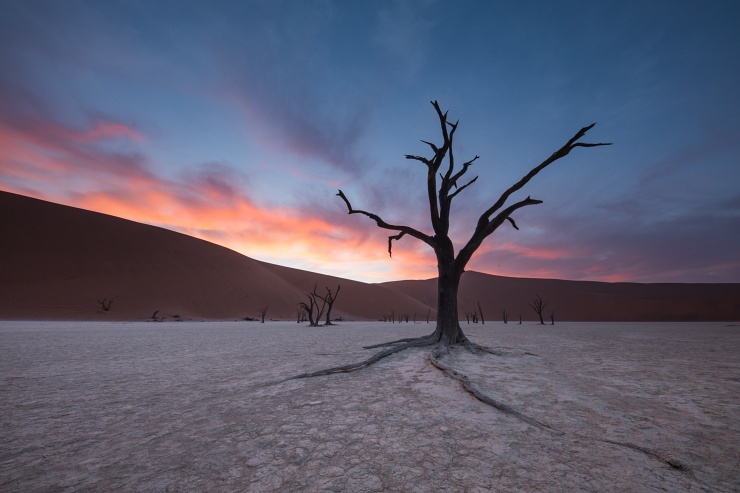
6:00 am
Wake up!
The access gate to the park opens in a few minutes and we want to be first in line. Our goal is to get to Deadvlei as soon as possible (before the end of the golden hour if we can). The aim is to capture the shadows cast by the dunes while meeting the white-salty soil of the ancient pan. There, the dead trees stand still, petrified.
It’s a dead forest.
The very moment the shadows reach the ground, we’ll be ready to shoot low, almost laying on the ground, to capture the magic golden color of the dunes, as the perfect background for our petrified trees, still in the shadows.
Getting to Deadvlei on time is part of the adventure. And driving the last kilometers is a unique experience. You’ll see.
Blue hour begins at 6:53 am, golden hour begins at 7:02 am, Sunrise is at 7:16 am and golden hour ends at 7:48 am.
9:00 am
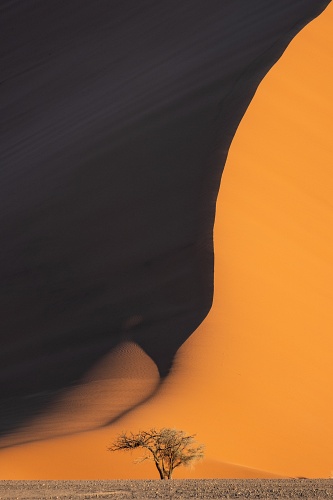
After a great morning start and a nice breakfast in Deadvlei, we’ll spend the morning photographing the beautiful landscapes and dunes around.
With its 325 m (1066 ft), Big Daddy is the tallest dune in the area. From the top, you have a unique view of Deadvlei.
2 km (1.2 mi) away from where we left the car, there is an area known as the Hidden Vlei. It’s a much less visited vlei. This hidden gem is a place to enjoy a bit of solitude in the desert vastness.
Dunes 40, 45 and 50 are also a must. We’ll stop to photograph them.
As we go from spot to spot, as we move from dune to dune, be ready to take any opportunity that arises to photograph the wildlife. Look, there’s an orix over there!
12:00 pm
We’ll find a nice and cool spot to stop for a while. It’s time to rest a bit and enjoy a delicious meal that our team has prepared for us.
2:00 pm
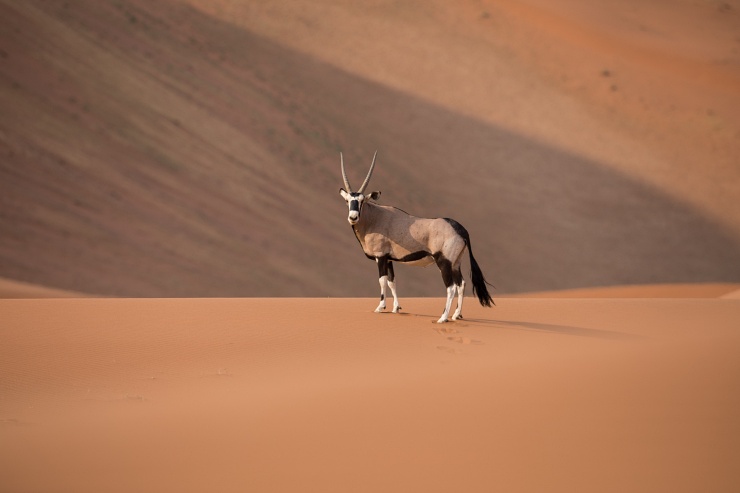
In the afternoon we’ll keep taking photos non-stop.
Jandré knows the area very well. He knows where to go to find great compositions. The dunes, the trees, the desert, the wildlife will give us lots of photo opportunities.
As the Sun goes down, we’ll head towards the access gate. On our way out we’ll stop to capture a few more photos. But remember that the gate closes at Sunset, and no one can stay inside the park.
Golden hour begins at 6:02 pm, Sunset is at 6:33 pm, blue hour begins at 6:47 pm and blue hour ends at 7:02 pm.
8:00 pm
Dinner and songs under the stars.
9:00 pm
You should go to bed early today. It’s been a long, long day.
But if you have some energy left, there is a cool shot you can take: a Star Trails with a dead tree.
The astronomical twilight begins at 7:24 pm and the Galactic Center is visible from 9:22 pm until 6:00 am. The Moon (17.8%) rises at 3:05 am.
12:00 am
Time to go to bed. Tomorrow, we’ll photograph a nearby beautiful dune at Sunrise before heading north, towards the Atlantic ocean.
Photographic Pills:
- Sunrise and golden hour at Deadvlei.
- Big Daddy dune.
- Hidden Vlei.
- Dunes 40, 45 and 50.
- Desert wildlife.
- Golden hour in the desert.
- Star Trails and dead tree.
Day 4. Wednesday, April 27th - Golden dunes and pink flamingos
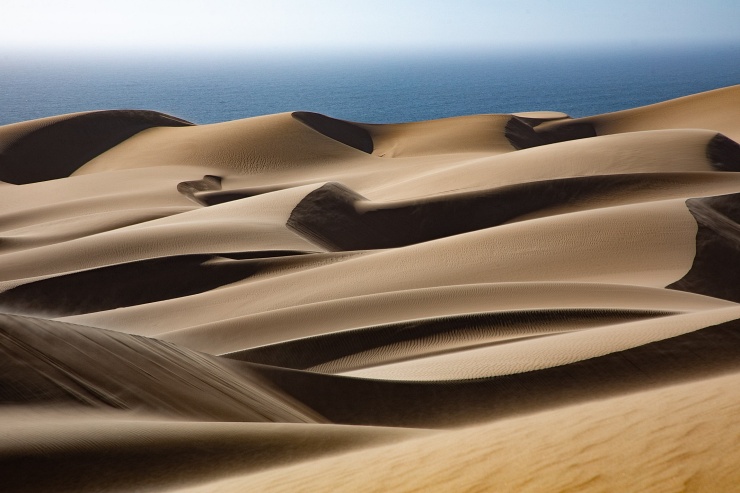
6:00 am
Good morning team!
Pick your camera because we’re heading to Elim Dune. It’s not far away, but we need to get there before the blue hour begins. Hurry up!
This golden dune covered by low crub is beautiful. It’s a great subject to be photographed at Sunrise. Also, you can easily climb it to enjoy a morning view of the desert.
Blue hour begins at 6:53 am, golden hour begins at 7:02 am, Sunrise is at 7:17am and golden hour ends at 7:48 am.
8:30 am
Breakfast at the camp and pack up. Get ready to depart.
10:00 am
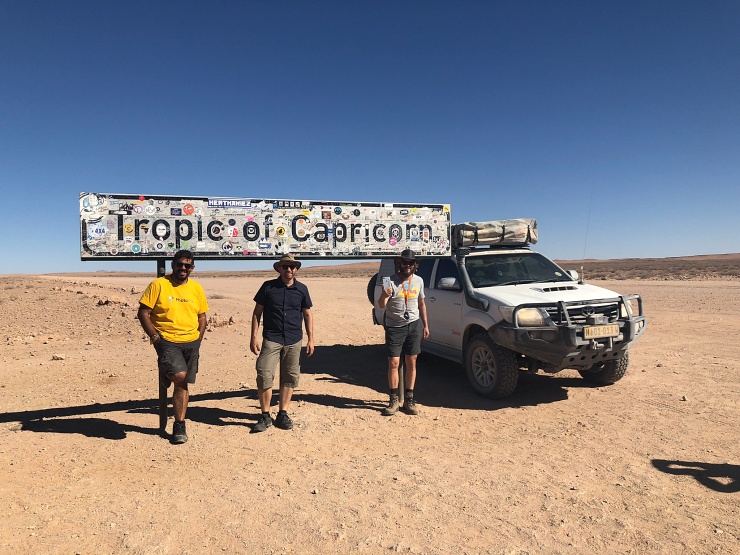
We’re on the road again. We’re heading north, toward the coast, in search of pink flamingos.
It’s a long way with many interesting stops.
First, we’ll stop at Solitaire, a remote dusty settlement at the edge of the Namib-Naukluft National Park. There we’ll find a few Quiver trees, several abandoned rusty vehicles and a tasty apple pie. It’s a great stop to stretch our legs and refill the tanks.
A bit more to the north, we’ll cross the Tropic of Capricorn. The big sign marking it is a great opportunity to take a selfie. It may be a bit touristy, but it’s fun and a great excuse to tell your relatives that you’re safe and sound.
1:00 pm
Stop for a quick lunch in the desert.
3:00 pm
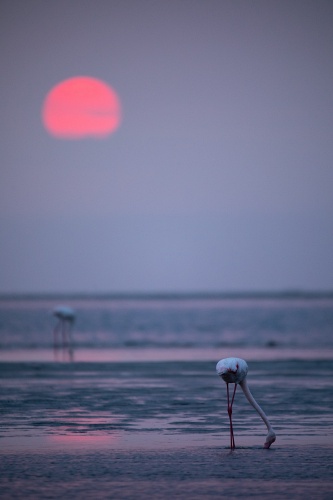
As soon as we arrive at Walvis bay, we’ll start searching for pink flamingos, great white pelicans and many more birds.
Walvis Bay is the second largest city in Namibia. It’s located on the Atlantic coast, north of the Namib-Naukluft National Park.
The bay is rich in plankton and marine life, like the southern right whale and the Cape fur seal.
Here we’ll spend the afternoon until Sunset photographing the rich bird diversity: flamingos, pelicans, chestnut-banded plovers, pied avocets, Cape teals and black-necked grebes…
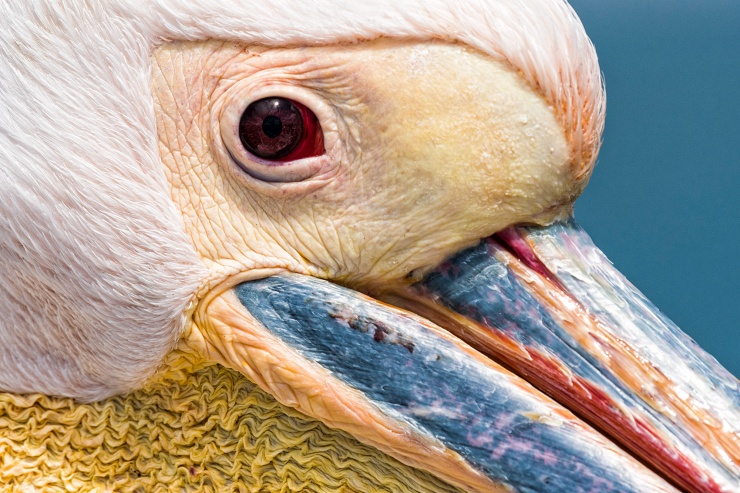
Over 150 species of bird have been recorded in the bay. Impressive!
Golden hour begins at 6:08 pm, Sunset is at 6:39 pm, blue hour begins at 6:53 pm and blue hour ends at 7:02 pm.
7:00 pm
After a 30-minute drive, we’ll arrive at our hotel in Swakopmund, the Sea Breeze Guest House. Here we check in, unpack our luggage and get ready for dinner.
With 44,725 inhabitants, Swakopmund is the fourth largest city in Namibia. Founded in 1892, it’s a true example of German colonial architecture. When you walk along its streets, a strange feeling invades you. Are you really in Africa?
8:00 pm
Tonight we’ll have dinner in a local restaurant, among tall palm trees.
9:30 pm
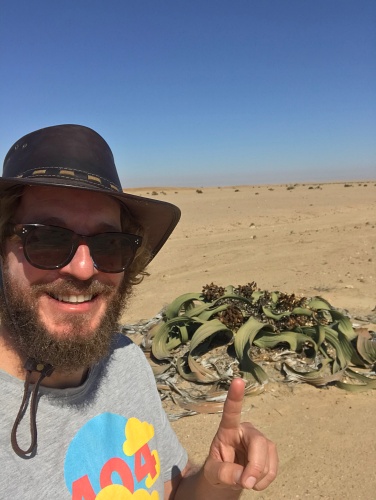
The Galactic Center is about to pop up in the sky. And we want to photograph it with a super rare endemic plant of the Namib desert. A plant that can live for more than a thousand years.
Yes, you guessed it right. I’m talking about the “beautiful” Welwitschia Mirabilis.
The astronomical twilight begins at 7:29 pm and the Galactic Center is visible from 9:28 pm until 6:03 am. The Moon (7.8%) rises at 5:03 am.
12:00 am
Bed time. Tomorrow is the Secret day :P
Photographic Pills:
- Sunrise, golden hour and blue hour at Elim dune.
- Settlement of Solitaire.
- Tropic of Capricorn.
- Pink flamingos, pelicans and many more birds in Walvis Bay.
- Welwitschia Mirabilis with the Milky Way and/or Star Trails.
Day 5. Thursday, April 28th - The secret
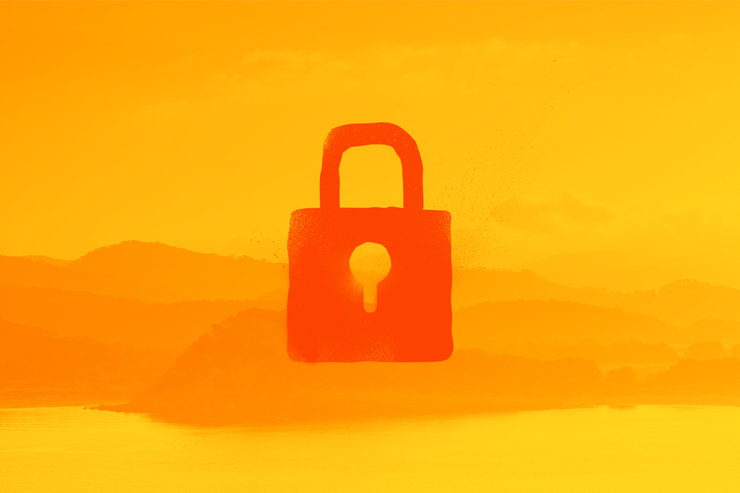
I’ve been giving you many details of this crazy expedition to Namibia.
Maybe even too many...
But on April 28th we’ll do something completely different. So different and fun that we’ve decided to keep it secret.
You'll have to be there, with us, to find out :P
Day 6. Friday, April 29th - The majestic Spitzkoppe

9:00 am
Nice shower, jam-packed breakfast and on to the vehicles. Today we’re going east, to Spitzkoppe.
With a height of 1,728 m (5,600 ft), Spitzkoppe is one of the icons of Namibia. This stunning rock formation is located in the desert of Namib, between the towns of Swakopmund and Usakos… And its shape inspired its nickname: the "Matterhorn" of Africa.
Spitzkoppe hides many secrets. And our mission is to discover them.
11:00 am
On our way to Spitzkoppe, we’ll stop to photograph it in the distance. As we get closer and closer the views are more and more stunning.
Before we get to our camp, there is an acacia that we need to find. Actually, it’s not only one acacia, but a few. These trees are strategically located and you can create a beautiful composition by placing a small acacia right in the middle of the view of Spitzkoppe.
We’ll scout the area until we find it, so we can plan our Sunrise and Sunset shots here.
1:00 pm
Once at the Spitzkoppe campsite, we’ll set up the camp near the Bridge and have lunch.
The Bridge is a stone natural arch that can be the perfect subject to photograph at any time of day. And during the Sunrise and the Sunset, or even at night.
3:00 pm
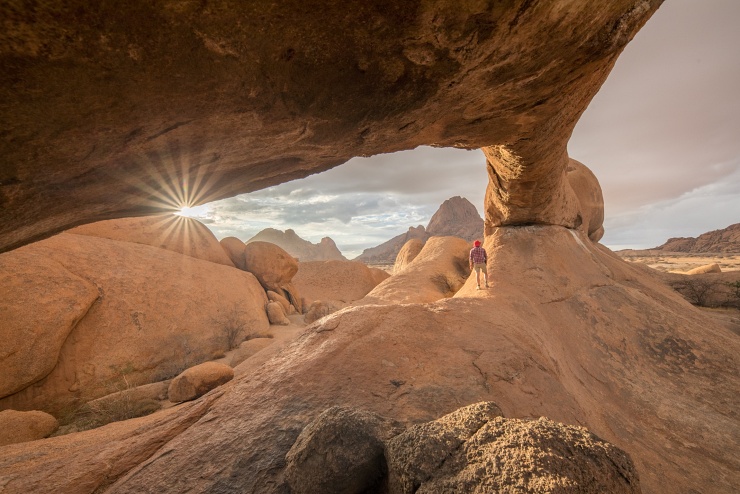
After resting a bit, we’ll scout the area around the Bridge to find cool compositions and angles. This is a great occasion to take your smartphone and use the Augmented Reality views included in PhotoPills to come up with multiple photo ideas in natural light, with the Sun, the Milky Way and Star Trails.
6:00 pm
We’re at the right shooting spot, waiting for the Sun to set. Your composition is ready with the acacia and the Spitzkoppe mountain range right where you want it to be. It’s time to press the shutter and create an amazing panorama, which will be one of the greatest images of our Namibian adventure.
Golden hour begins at 6:05 pm, Sunset is at 6:36 pm, blue hour begins at 6:50 pm and blue hour ends at 6:59 pm.
8:00 pm

As usual, we’ll eat something on the fly. Because when you love photography, you forget to eat. It happened to us in Iceland and Faroe Island several times. I’m not joking!
There is no time to waste...
The Milky Way dance begins. You’ll notice that its position varies throughout the night: first horizontal, then diagonal and finally vertical.
We’ll spend as much time as we need to photograph our galaxy and its Core with a stone bridge.
The astronomical twilight begins at 7:26 pm and the Galactic Center is visible from 9:20 pm until 6:01 am. It's almost the New Moon phase.
12:00 am
Off to bed. It feels so good to sleep under the stars!
Photographic pills:
- Long distance shots of Spitzkoppe.
- Sunset, golden hour and blue hour with Spitzkoppe and an acacia tree.
- Milky Way and the Bridge.
Day 7. Saturday, April 30th - The Herero tribe

6:00 am
Yesterday afternoon, during the Sunset, the Sun was right behind Spitzkoppe. That’s why the rock formation was a bit dark in our photos. But during the Sunrise, the light hits our subject from the side, enhancing its volume, texture and golden and red tones. Spectacular!
The idea is to repeat the panorama we took the day before. However, this time we’ll try to capture the acacia tree and Spitzkopppe in much better light conditions.
Blue hour begins at 6:54 am, golden hour begins at 7:03 am, Sunrise is at 7:17 am and golden hour ends at 7:48 am.
8:30 am
Breakfast at the camp and down time.
11:00 am
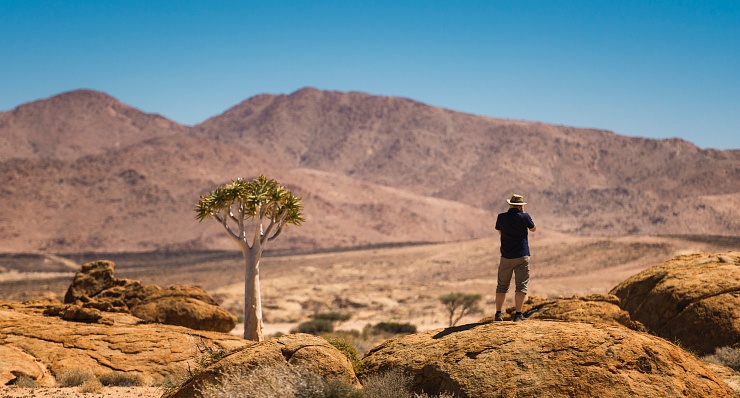
Switch on the scouting mode because Spitzkoppe hides many treasures. One of them is a beautiful Quiver tree. This one is not easy to find, but we’ve been told it is there, hidden somewhere.
The Quiver tree (Aloidendron dichotomum) is indigeous to South Africa and Namibia. Believe it or not, it’s not really a tree, but a species of Aloe (succulent plant) that can reach a height of 9 m (30 ft).
The plan is to find the tree and plan a few Milky Way shots with it. Why not a panorama capturing the whole Milky Way arch and the Quiver tree beneath? That’s just an idea :)
1:00 pm
Back to the camp, where our Camp Masters have prepared our lunch. It’s a beautiful day. And life is good.
3:00 pm
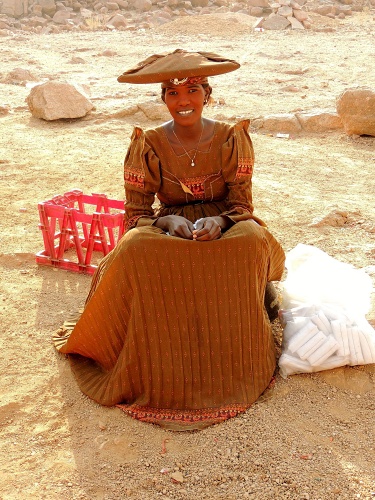
We’re visiting the Herero people, a Batnu ethnic group that makes a living tending livestock.
The heavy influence of western culture explains the colorful identity adopted by the Herero group living in central Namibia.
Thanks to their colorful hats and dresses, their look is unique and vibrant.
You surely can’t wait to learn more about their culture and lifestyle. And you’re dreaming of photographing them during golden hour.
Golden hour begins at 6:05 pm, Sunset is at 6:35 pm, blue hour begins at 6:50 pm and blue hour ends at 6:59 pm.
8:00 pm
Dinner at the camp while we’re waiting for the stars to appear in the sky.
9:30 pm
Plan A is to photograph the Milky Way and the Quiver tree we found in the morning.
But…
If we’re lucky and the Herero people agree, it would be cool to photograph them under the stars.
Once we’re there, among them, we’ll try to convince them to pose for us under the Milky Way.
The astronomical twilight begins at 7:25 pm and the Galactic Center is visible from 9:20 pm until 6:01 am. The lunar phase is New Moon.
12:00 am
Bed time!
Tomorrow we’re heading north, in search of the Fire Mountain, the White Lady and the Desert Elephant.
Photographic pills:
- Sunrise, golden hour and blue hour with Spitzkoppe and an acacia tree.
- Sunset, golden hour and blue hour with the Herero people.
- Milky Way and the Quiver tree. And maybe the Herero too.
Day 8. Sunday, May 1st - The Fire Mountain and the White Lady

9:00 am
After having our last breakfast among the red rock formations of Spitzkoppe, we’re heading north, towards the impressive Brandberg mountains.
In the next two days, we’ll be photographing a spectacular mountain range, arid landscapes, Quiver trees, a rock painting known as the White Lady... and most importantly, the Desert Elephants.
It’s a 3-hour drive to our camp by the Brandberg mountains, The White Lady Lodge Camp.
12:00 pm
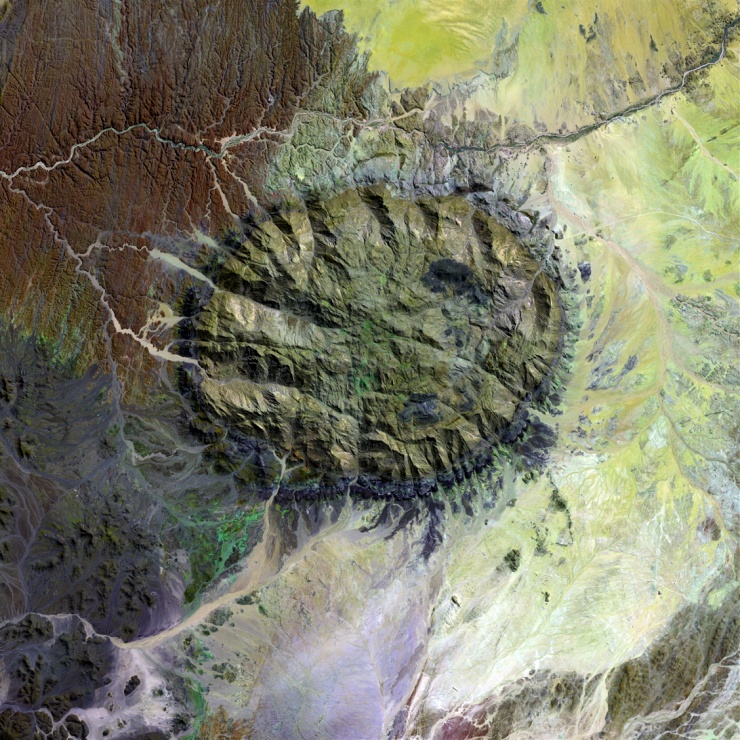
Brandberg means “fire mountain” in German. The massive granite mountain range got its name due to the scarlet color it gets at Sunrise and at Sunset.
Look! There you have it!
The desert and the Brandberg mountains. The mountain range has an almost perfect 32 km (20 mi) circular shape and it includes the highest point in Namibia, the King’s Stone (Königstein), with a height of 2600 m (8,550 ft).
Take your cameras out, it’s time to shoot.
1:00 pm
Lunch at the camp and down time.
3:00 pm
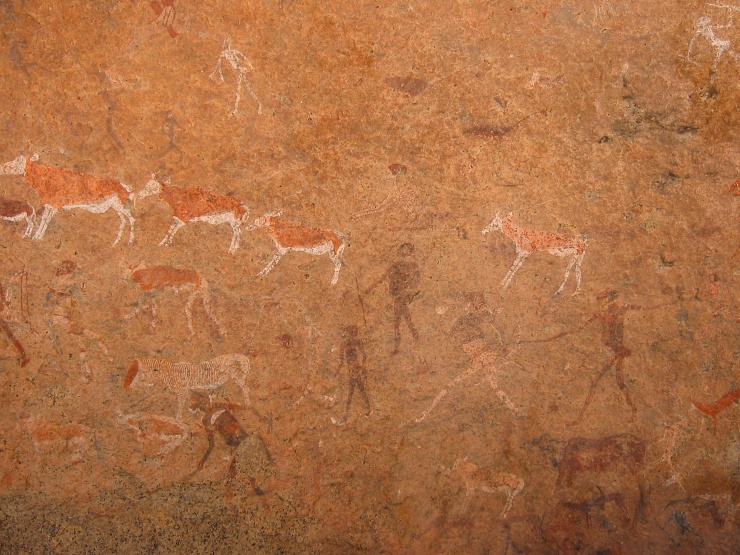
We have a lot to do.
First, we’ll hike for about an hour over rough terrain to visit and photograph the White Lady. This unique rock painting is hidden among the more than 1,000 bushmen paintings scattered around the brandberg mountains. It represents a detailed human figure among other human figures and oryxes.
Second, we’ll scout the area in search of a great spot from where to photograph the Brandberg massif in the distance at Sunset and at Sunrise the following day.
And third, we’ll look for cool rock formations and a Quiver tree for our Milky Way (or Star Trails shot.
Of course, we’ll use PhotoPills to plan our Sunset, Sunrise and Milky Way shots to the very last detail.
6:00 pm
Place your tripod at the planned shooting spot. The Sun is going down towards the west, and over the magnificent circular mountain range. Enjoy the moment!
Golden hour begins at 6:07 pm, Sunset is at 6:38 pm, blue hour begins at 6:52 pm and blue hour ends at 7:01 pm.
8:00 pm
Dinner at the camp.
9:30 pm
Remember the Quiver tree we found in the morning? And the beautiful rock formation?
Well it’s time to photograph it with a beautiful diagonal of the Milky way and its Core.
The astronomical twilight begins at 7:27 pm and the Galactic Center is visible from 9:15 pm until 6:03 am. The Moon (2%) is below the horizon.
12:00 am
Bed time!
Tonight we’ll see desert elephants in our dreams. Tomorrow we’ll photograph them.
Photographic pills:
- The White Lady rock paintings.
- Sunset, golden hour and blue hour with the Brandberg mountain.
- Milky Way and the Quiver tree.
Day 9. Monday, May 2nd - The desert elephants
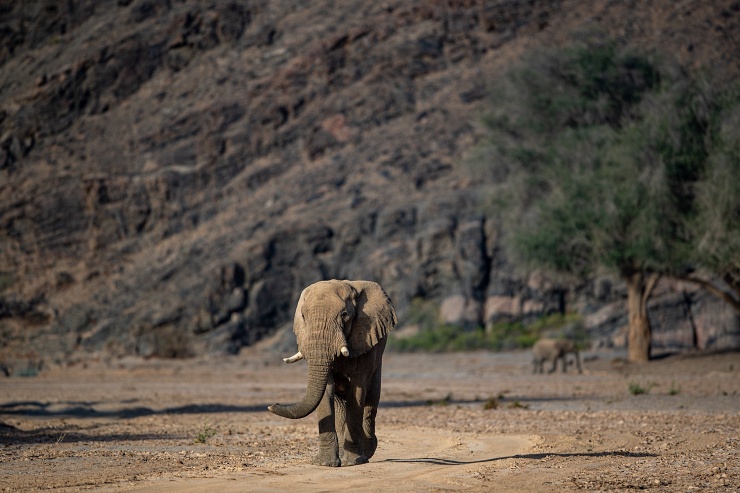
6:00 am
Wake up!
The Sun is about to rise. And when doing so, it’ll fill the Brandberg massif with a glowing scarlet color.
Yesterday we got the Sun in the frame. Today we’ll go after the morning colors: blue, red, and gold.
Blue hour begins at 6:56 am, golden hour begins at 7:05 am, Sunrise is at 7:19 am and golden hour ends at 7:50 am.
9:00 am
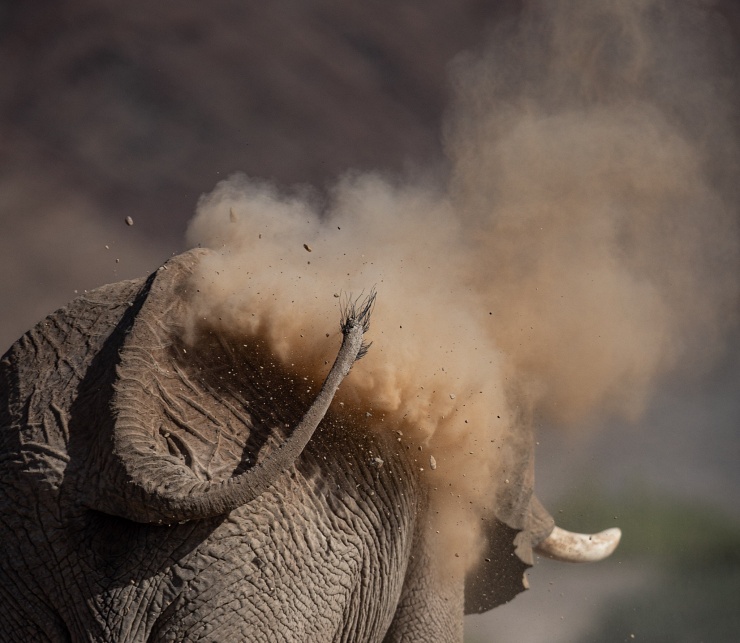
After having our breakfast at the camp, we’ll jump onto our 4x4 vehicles in search of the rare elephant of the desert.
These elephants are tough as a rock. They have learned to survive the harsh conditions of the desert, with very little water. This extreme situation has led them to develop unique conditions. They are thinner and taller than the rest of the African elephants. And they even have wider hooves.
They are definitely not easy to spot, so we’ll spend all day on safari tracking them with the help of Jandré.
1:00 pm
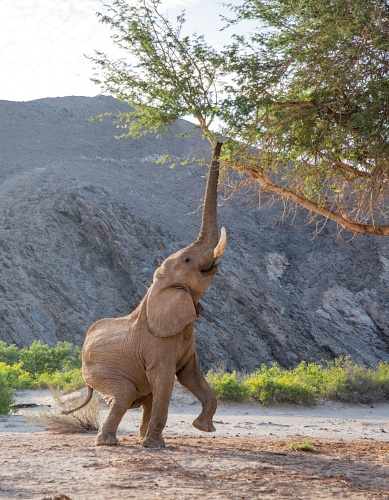
When we’re hungry, we’ll stop in a beautiful place and devour our lunch.
Look over there! More elephants!
In the afternoon, we’ll continue our adventure to photograph the desert elephants up and down the Ugab river.
And on our way back to the camp, we’ll stop to photograph the Sunset. And right after Sunset, during the blue hour, the Moon (3.3%) will approach the horizon. How cool is that?!
Golden hour begins at 6:06 pm, Sunset is at 6:36 pm, blue hour begins at 6:51 pm and blue hour ends at 7:00 pm.
8:00 pm
Dinner at the camp.
9:30 pm
It’s been a long long day. So the plan is to just relax at the camp while enjoying a cold beer under the stars. Tempting, isn’t it?
Of course, if you have some energy left you can always photograph the Milky Way :)
The astronomical twilight begins at 7:26 pm and the Galactic Center is visible from 9:11 pm until 6:03 am. The Moon (3.9%) is below the horizon.
12:00 am
Bed time!
Tomorrow we’ll spend the day with the Himba people!
Photographic pills:
- Sunrise, golden hour and blue hour with the Brandberg mountain.
- The desert elephant (if we’re lucky).
- Sunset, golden hour and blue hour on our way back to the camp.
- Moon (3.3%) in blue hour.
- Milky Way near the camp.
Day 10. Tuesday, May 3rd - The Himba
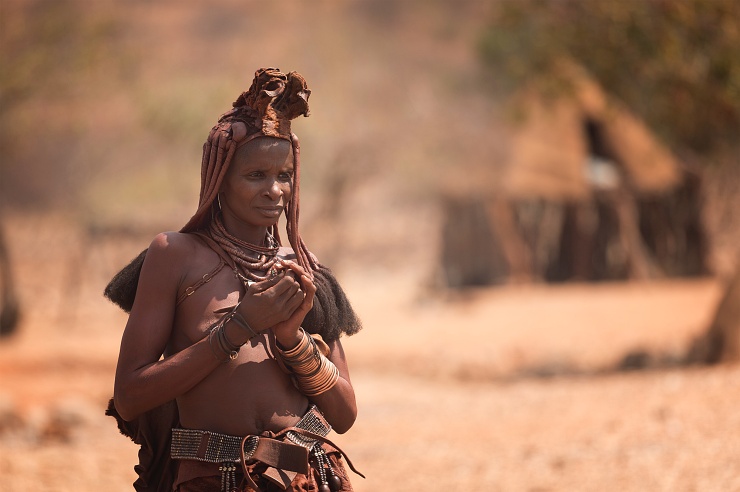
6:00 am
Optional Sunrise shooting session at the Brandberg mountains.
Blue hour begins at 6:55 am, golden hour begins at 7:04 am, Sunrise is at 7:18 am and golden hour ends at 7:49 am.
9:00 am
Breakfast before we’re heading north towards Onjowewe, while crossing the Namibian desert landscapes. It’s a 3-hour drive to the Onjowewe Tented Camp, where we’ll spend the night.
12:00 pm
Lunch at the camp and down time. It’s always good to rest a bit and stretch our legs before we move onto our next destination, a Himba village.
The Himba are an ancient tribe in Namibia, closely related to the Herero. They are tall, beautiful and super friendly. Their skin is rubbed with red ochre and their hairstyle is unique and beautifully decorated.
The Himba live a semi-nomadic life, breeding cattle and goats. They’ve learned to survive in the harsh conditions of the desert.
3:00 pm
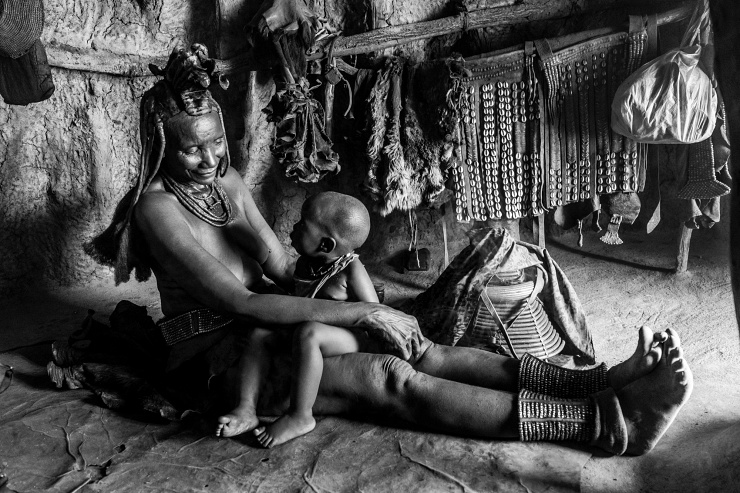
We’ll spend the afternoon with the Himba, learning their customs and taking photographs.
Besides that, we have a very important mission to take care of... We need to find among the members of the tribe some volunteer(s) that we can use as models to photograph them at night, under the stars.
Golden hour begins at 6:07 pm, Sunset is at 6:38 pm, blue hour begins at 6:52 pm and blue hour ends at 7:01 pm.
8:00 pm
Dinner at the camp.
9:30 pm
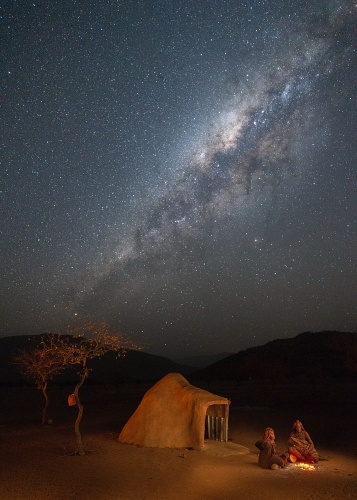
The astronomical twilight ends at 7:52 pm, just when the Milky Way describes a beautiful arch. And at 10:00 pm our galaxy will be perfectly located in the sky for a panorama.
We have several hours ahead to enjoy a dark and starry sky.
And if the negotiations have gone well in the morning, we’ll spend the night with our hosts, the Himba.
The astronomical twilight begins at 7:27 pm and the Galactic Center is visible from 9:11 pm until 6:02 am. The Moon (8.2%) is below the horizon.
12:00 am
Bed time!
Tomorrow we’ll stop to photograph a very particular rock formation on our way to Etosha National park, a true wildlife realm.
Photographic pills:
- Sunrise, golden hour and blue hour with the Brandberg mountain.
- Sunset, golden hour and blue hour with the Himba.
- Milky Way with the Himba (if possible).
Day 11. Wednesday, May 4th - The Finger of the Gods

9:00 am
We'll resume our journey, crossing Damaraland towards the terraces of Ugab, where a spectacular rock formation awaits us: the Vingerklip.
Known as the "finger-shaped rock" or, as we call it, the "finger of the Gods", the Vingerklip dominates the Ugab valley from the top of a hill thanks to its 35 meters height.
Yes, I know... We all dream of making a panoramic view of the Milky Way over the rock... But patience because we’re not there yet. I can’t wait!
Along the way, we’ll look for all the photographic opportunities that come our way. Remember that we are in Africa. At any moment something unexpected can happen so you have to be vigilant.
1:00 pm
Our lodge, the Vingerklip Lodge, is only a 5-minute drive away from the Vingerklip. There, we’ll stop to rest, cool off and eat something.
I don’t know about you, but after devouring my lunch, I plan to go to the bar of the lodge and enjoy a cold beer. Then, I’ll take a good nap in a comfortable room to keep my old good habits despite being in Africa… ;)
4:00 pm
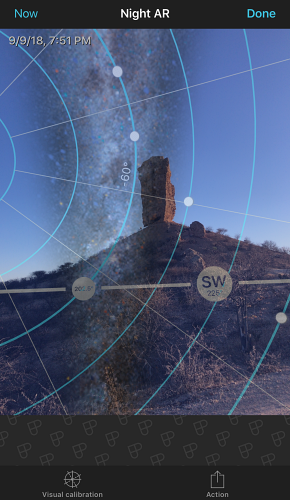
Wake up! We have a lot to do.
It’s time to go to scout the area around the Vinglerklip and plan a few shots. One for the Sunset, one for the Milky Way and another for the Sunrise. We’ll teach you how to use PhotoPills to find them.
6:00 pm
The Sun sets at 6:34 pm. There are many photo opportunities with the Vingerklip as the main subject.
We’ll be in the right place and time to capture a spectacular photo of the Sunset with the rock formation.
Golden hour begins at 6:03 pm, Sunset is at 6:34 pm, blue hour begins at 6:48 pm and blue hour ends at 6:57 pm.
8:00 pm
Dinner at the lodge. It feels good not to camp tonight, doesn't it?
9:30 pm
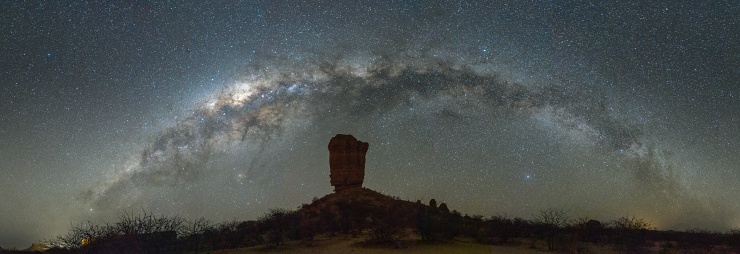
We’ll take our first Milky Way photo at 9:30 pm, combining the vertical shape of the rock with our galaxy.
And we won’t stop taking pictures until midnight.
One of the most exciting moments will happen around 10:00 pm, when the Milky Way forms a perfect arch over our subject, the Vingerklip.
Can you imagine the photo?
12:00 am
Today we'll go to bed happy with all the images we captured. And we’ll sleep soundly...
Photographic pills:
- Desert landscapes of Damaraland.
- Sunset at the Vingerklip.
- Milky Way and Star Trails with the Vingerklip.
Day 12. Thursday, May 5th - The Etosha big 4
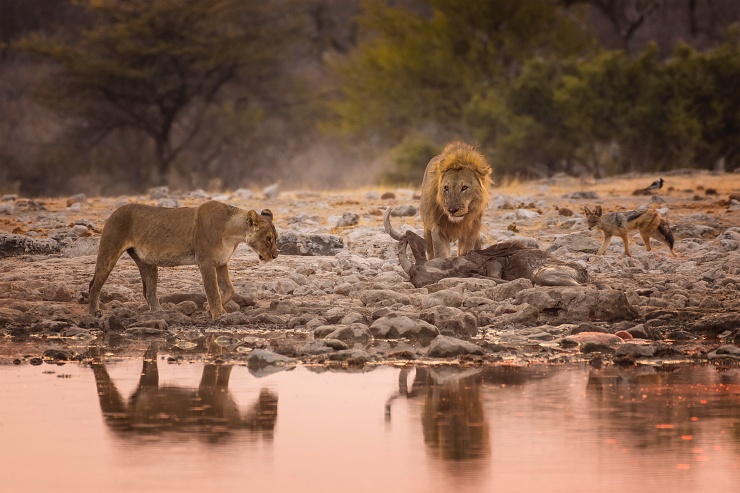
6:00 am
Optional Sunrise shooting session at the Vingerklip. And for the brave ones, the Milky Way gets vertical at 4:15 am.
Blue hour begins at 6:53 am, golden hour begins at 7:02 am, Sunrise is at 7:16 am and golden hour ends at 7:47 am.
9:00 am
Delicious breakfast at the lodge and back to the cars. Today we’re heading east as we’re going to Etosha National park.
In its more than 22,000 km of incomparable landscapes, Etosha is home to 114 species of mammals, including 4 of the Big Five: lion, leopard, elephant and rhinoceros. It’s also the habitat of more than 400 species of birds and 110 species of reptiles... Tons of them!
In addition to this, among its treasures are three species of antelope: the beautiful black-faced impala, the elegant roan antelope and the small Damara dik-dik – the smallest antelope in southern Africa as it’s only 40 cm tall.
Did you hear it? It’s a lion roaring.
12:00 pm
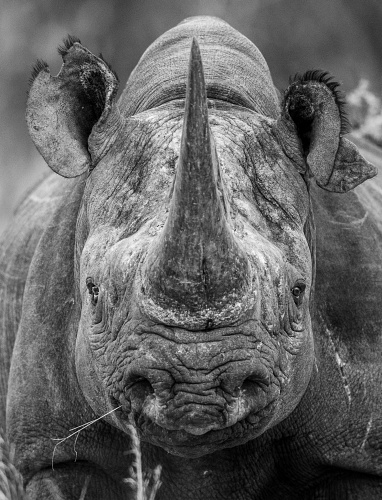
We arrive at Anderson Gate, one of the gateways to Etosha. After arranging the papers with the rangers, we’ll enter the national park... Astonishing.
We'll stop for lunch when we’re hungry, and we’ll continue our photo safari in Etosha until Sunset.
I can’t wait to be among elephants, giraffes, zebras, impalas, oryxes, hyaenas, lions...
But remember that the gate of our camp closes at Sunset. So we need to make sure we get through it in time.
Golden hour begins at 6:03 pm, Sunset is at 6:33 pm, blue hour begins at 6:47 pm and blue hour ends at 6:56 pm.
7:00 pm
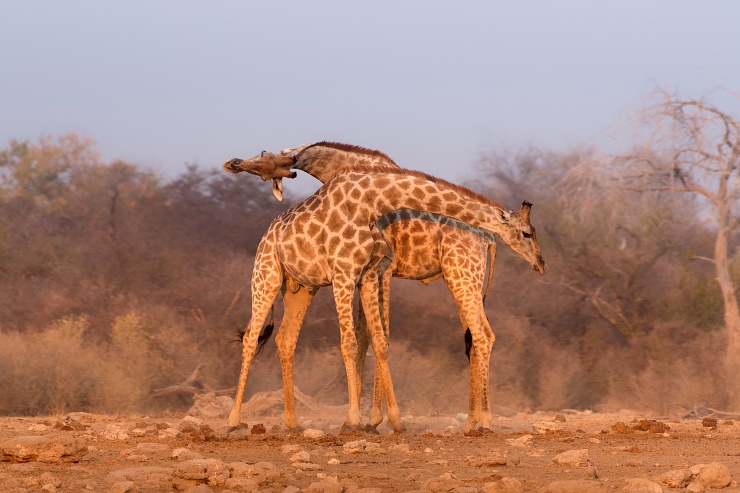
We arrive at Okaukuejo Campsite, a camp with all the comforts within Etosha!
We’ll park our vehicles, pitch our tents, take out the tables and chairs... And after a nice shower, we’ll enjoy a more than deserved dinner. What about a barbecue?
9:00 pm
In Okaukuejo there is a spectacular whaterhole. There we can wait for the night to come while watching a large variety of wildlife that comes to drink and refresh after a long day under the Sun.
And when the Milky Way is in position... we’ll be there, ready to capture it :P
The astronomical twilight begins at 7:22 pm and the Galactic Center is visible from 8:56 pm until 5:58 am. The Moon (27.9%) sets at 10:59 pm.
11:30 pm
While you’re trying to get to sleep you can barely hear the wind, some animals through the canvas of the tent... And the noise of some PhotoPillers’ camera shutters photographing the Milky Way.
Photographic pills:
- Sunrise, golden hour and blue hour at the Vingerklip.
- African savannah and the opportunities that arise on the way to Etosha.
- Wildlife in Etosha.
- Wildlife at the Okaukuejo Camp waterhole.
Day 13. Friday, May 6th - The wonders of Etosha
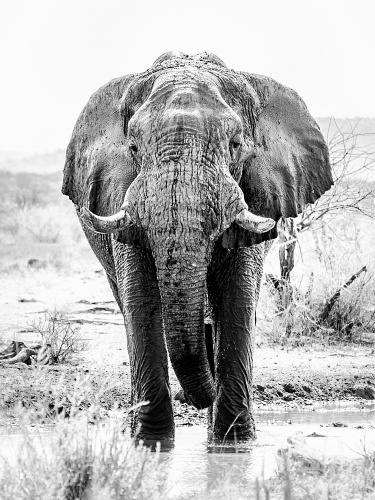
6:00 am
The gate opens at Sunrise. And when this happens, we’ll be first in the queue, ready to access the park. The plan is to quickly get to a nearby waterwhole and photograph the wildlife during golden hour.
The waterwhole might be empty or packed, you never know. But that’s the photography game. Rule #1 is to be always ready at the shooting spot, patiently awaiting for the right moment to come.
Over there! An elephant is approaching!
Blue hour begins at 6:50 am, golden hour begins at 6:59 am, Sunrise is at 7:13 am and golden hour ends at 7:44 am.
9:00 am
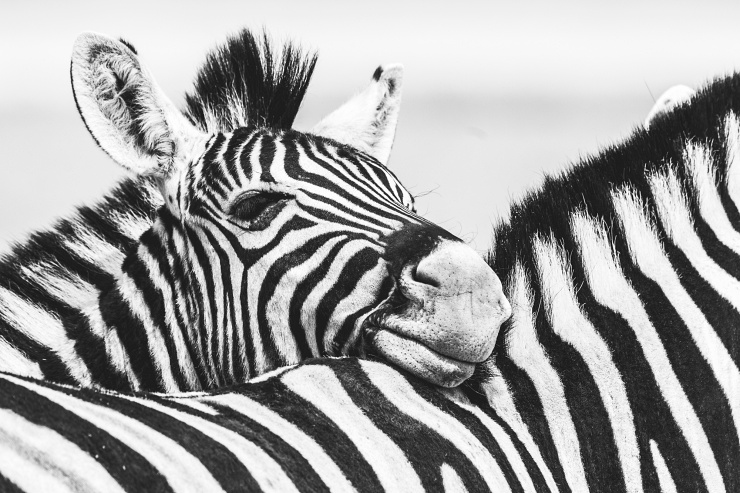
Breakfast at the camp and back to the vehicles.
Thanks to Jandré’s expertise, today we’ll explore the most frequented waterholes on the west side of Etosha.
12:00 pm
At some point we'll stop for lunch and then continue our safari through the Etosha savannah. But keep your eyes open in case something unexpected suddenly happens.
By the way...
It’s out of the question to get off the vehicle In Etosha. It’s big cats’ territory!
We’ll continue going up and down Etosha in search of all kinds of wildlife.
6:00 pm
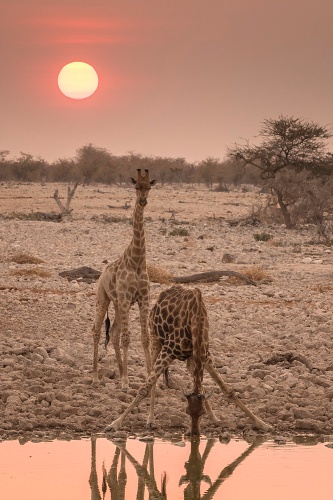
Before the golden hour begins, we’ll be back at the Okaukuejo Campsite. Next to the waterhole to be more precise.
Why?
Well...
Because according to PhotoPills the Sun will set aligned with the waterhole, giving us a great opportunity to photograph giraffes, elephants or even rhynos along with the setting Sun.
Golden hour begins at 6:02 pm, Sunset is at 6:33 pm, blue hour begins at 6:47 pm and blue hour ends at 6:56 pm.
9:00 pm
Dinner time at the camp and back again to the waterwhole. The truth is we never get tired of photographing the thirsty wildlife.
The astronomical twilight begins at 7:22 pm and the Galactic Center is visible from 8:52 pm until 5:58 am. The Moon (34.9%) sets at 11:52 pm.
11:00 pm
Bed time! Rest well my friend. Because tomorrow another exciting day awaits!
Photographic pills:
- Sunrise, golden hour and blue hour at a whaterhole near Okaukuejo.
- Wildlife in Etosha.
- Wildlife at the waterhole of Okaukuejo.
Day 14. Saturday, May 7th - The Etosha pan
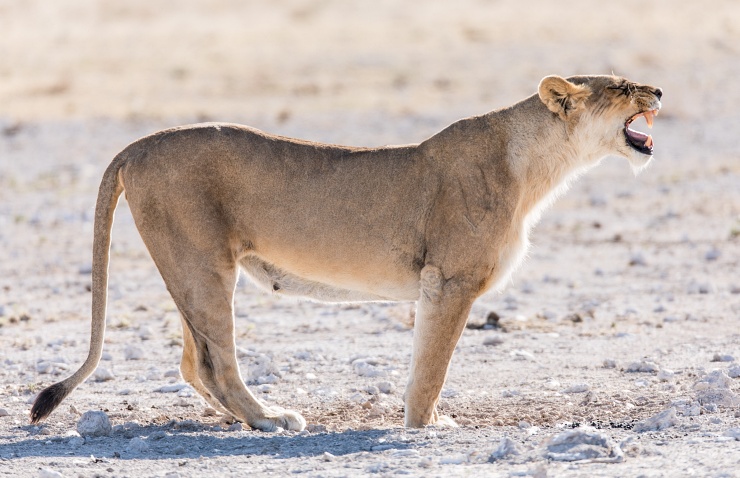
6:00 am
The gate opens again at Sunrise. And we won’t miss the opportunity to get into the park to photograph the diverse wildlife around the camp during the golden hour.
As Galen Rowell used to say:
“You only get one sunrise and one sunset a day, and you only get so many days on the planet. A good photographer does the math and doesn't waste either.”
Blue hour begins at 6:53 am, golden hour begins at 7:02 am, Sunrise is at 7:16 am and golden hour ends at 7:47 am.
9:00 am
After a healthy breakfast at the Okaukuejo Campsite, we’ll pack up everything and start driving towards the east, across Etosha.
The plan is to spend the whole day photographing the wildlife we encounter...
12:00 pm
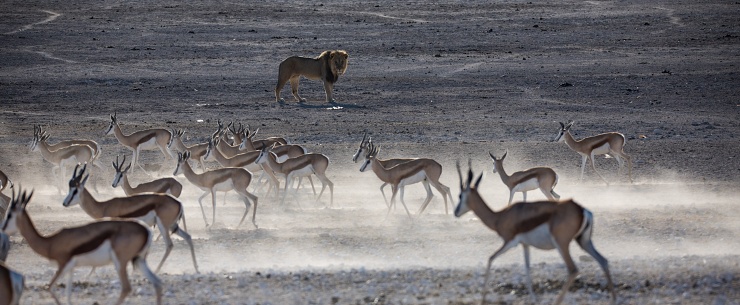
We’ll drive to the central area of the park, where the salt crust of Etosha pan, an ancient lake that was once fed by the waters of the Kunene River, is. Your eyes will be delighted with the white landscape…
The tectonic movements of the Earth's crust altered the course of the river condemning the pan to become what it is today: a white desert!
We’ll stop our expedition somewhere inside the park to rest, cool off and have lunch in the middle of the savannah.
In the afternoon, we’ll continue crossing Etosha in search of all kinds of animals.
6:00 pm
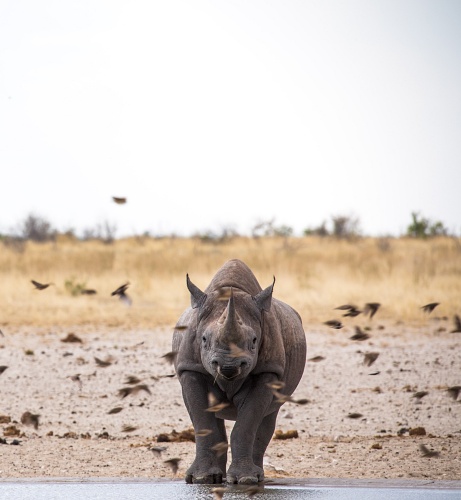
Today we’re camping at Halali Camp, right at the heart of Etosha. Close to the camp, we find some of the most spectacular whaterholes of the whole national park. They will provide us with great conditions to photograph the wildlife at Sunrise.
At Sunset, we’ll be inside the camp, by a floodlit waterhole with excellent day and night game viewing.
The thicker vegetation surrounding the camp makes this area popular with leopards, rhinos and elephants. Isn't this good news?
Golden hour begins at 6:01 pm, Sunset is at 6:30 pm, blue hour begins at 6:45 pm and blue hour ends at 6:54 pm.
9:00 pm
Dinner at the camp and back again to the waterwhole.
The astronomical twilight begins at 7:20 pm and the Galactic Center is visible from 8:51 pm until 5:56 am. The Moon (39.0%) sets at 11:50 pm.
11:00 pm
It’s been a long long day of photography. Sleep well my friend. The adventure will resume tomorrow.
Photographic pills:
- Sunrise, golden hour and blue hour at a whaterhole near Okaukuejo.
- Etosha Pan.
- Wildlife in Etosha.
- Wildlife at the waterhole of Halali.
Day 15. Sunday, May 8th - The leopard quest
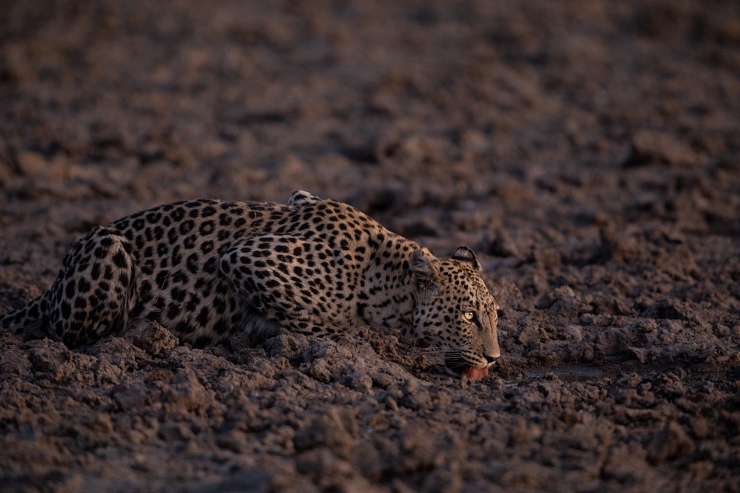
6:00 am
We wake up in Etosha for the last time. Today we’re moving south in search of leopards.
The Sun is about to rise, the gate of Halali opens and we immerse ourselves again into the great outdoors. We’re ready to press the shutter to take advantage of any opportunity to photograph a lioness, an elephant or an impala in the morning golden light.
Blue hour begins at 6:53 am, golden hour begins at 7:02 am, Sunrise is at 7:16 am and golden hour ends at 7:47 am.
9:00 am
After another great breakfast prepared by our Camp Masters team, we’re ready to depart.
It’s a 6-hour journey to our next destination.
First, we’ll go east. While crossing Etosha we’ll enjoy and photograph the wildlife game.
Then, we’ll cross Anderson Gate and go south towards Okonjima Wildlife Reserve. There we’ll sleep in comfortable rooms for two nights.
Okonjima is a 20,000-hectare nature reserve surrounded by the sandstone Omboroko Mountains, very rich in wildlife and picturesque landscapes. It’s also home to The AfriCat Foundation, which is renowned for its conservation work with predators across Namibia.
1:00 pm
Right after arriving at Okonjima, we’ll check into the lodge. No camping tonight and tomorrow night... Hooray!
3:00 pm
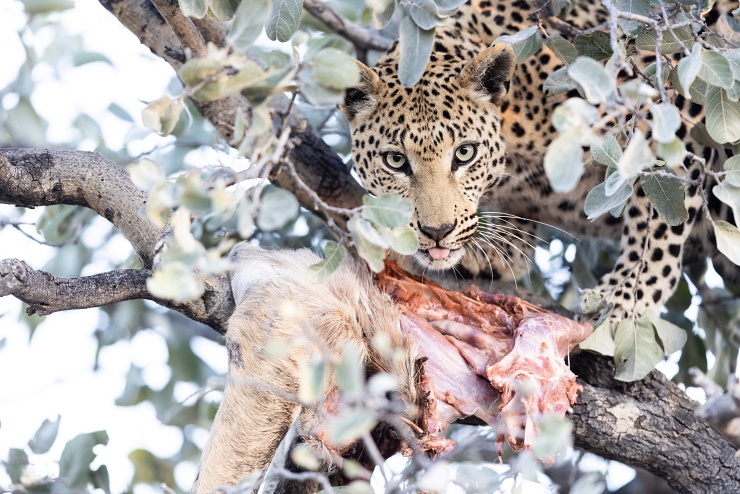
A dense population of leopards dwells in Okonjima.
However, spotting them is not easy. So we’ll climb on special vehicles and with the help of an expert guide, we’ll adventure into the savannah in search of the leopard.
The plan is to spend the next two days photographing this intelligent and solitary predator.
Golden hour begins at 5:59 pm, Sunset is at 6:30 pm, blue hour begins at 6:44 pm and blue hour ends at 6:53 pm.
8:00 pm
It’s been a long long day of photography. So it’s time to cool down by the swimming pool, and enjoy a tasty dinner at the restaurant of the lodge.
If you have energy left, you can always go and photograph the stars :)
The astronomical twilight begins at 7:16 pm and the Galactic Center is visible from 8:41 pm until 5:57 am. The Moon (46.3%) sets at 12:40 am (the following day).
Photographic pills:
- Sunrise, golden hour and blue hour at a whaterhole near Halali.
- Etosha Pan.
- Wildlife in Etosha.
- Wildlife in Okonjima (including leopards!).
Day 16. Monday, May 9th - Leopards, hyaenas and pangolins
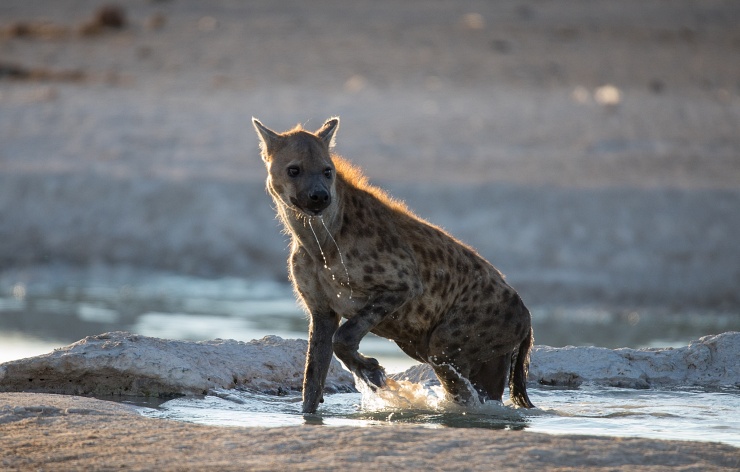
6:00 am
Okonjima is a natural reserve very rich in wildlife. And the Sun is rising again... So we’ll pick our gear and go out to take advantage of the best light. What a treat!
Another good option is to stay in bed, and enjoy the comfortable mattress for a bit longer :P
Blue hour begins at 6:50 am, golden hour begins at 6:59 am, Sunrise is at 7:14 am and golden hour ends at 7:45 am.
9:00 am
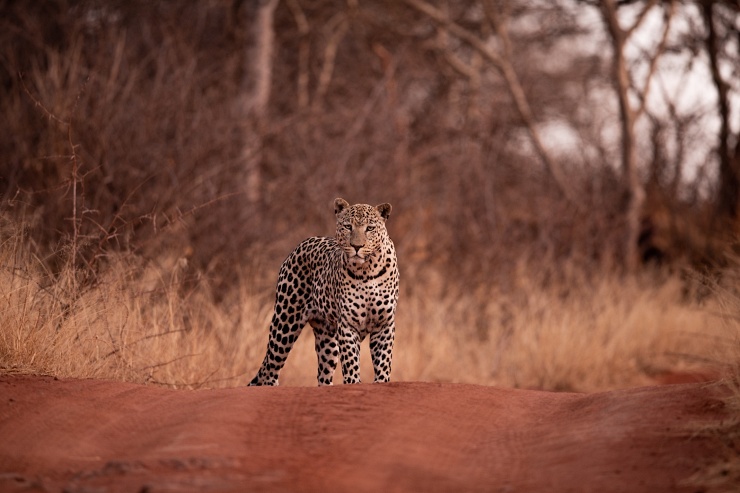
After a buffet style breakfast at the lodge, the vehicles and our guides will be waiting for us. Today we’ll spend the morning photographing leopards, hyaenas, pangolins, giraffes and more.
1:00 pm
Lunch at the lodge and time to chill.
Free time during the rest of the afternoon, so you can do pretty much what you want. Today it's time to relax, edit photos and enjoy a bit of tranquility.
Unfortunately, the trip is coming to an end.
But before the farewell, we want to take you out for dinner, a very special dinner in the middle of the savannah, under the stars.
8:00 pm
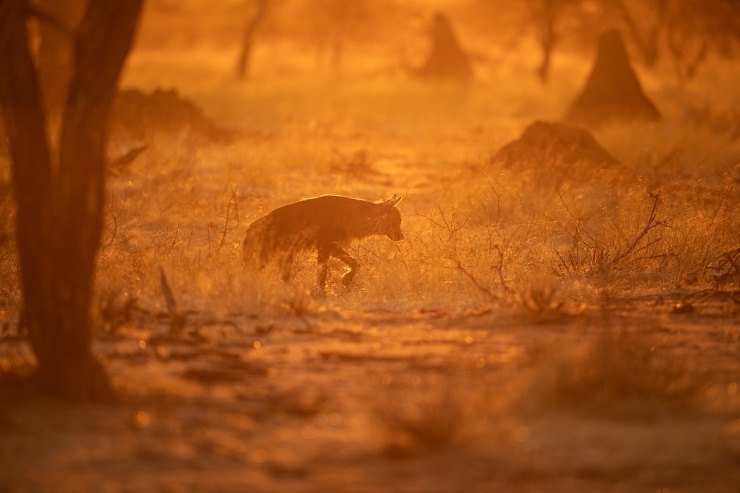
We’ll go to a remote location in the wild, where they’ll be waiting for us with the table set. It's not a restaurant, but we won’t have to cook either. We’ll be amazed by the local chef.
It will be our last dinner in Namibia... And we’ll remember it for the rest of our lives.
Photographic pills:
- Sunrise, golden hour and blue hour at a whaterhole near Okonjima.
- Leopards, hyaenas, pangolins and more in Okonjima.
- Bush dinner group photo.
Day 17. Tuesday, May 10th - Life goes on...
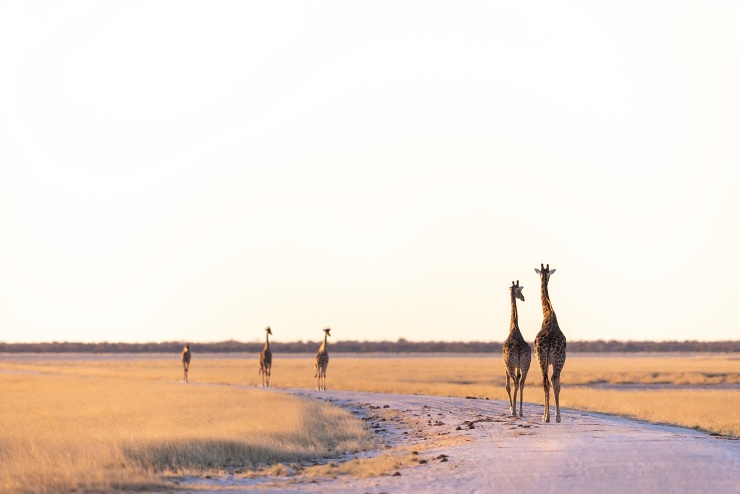
The Sun rises...
After our last breakfast together, we’ll drive to Windhoek.
Okonjima is about 3 hours from the airport. Fly in the afternoon so you don’t have to get up early. Or better yet, fly on Wednesday.
It's time to say goodbye.
See you soon friends!
Life goes on...
Book now and save €500 (only 14 spots)
To book your spot to join the expedition to Namibia at a reduced price of €5,500 (the official price is €6,000), a €1,000 deposit is required by Sunday, November 7th.
Payment in full is required by January, 30th 2022.
Please, finalize your booking as soon as possible. The seats are sold on a first come, first served basis.
What’s included in the price
- PhotoPills Welcome kit.
- Pick up at Windhoek airport and transfer to the hotel. Transfer to Windhoek airport at the end of the adventure.
- A 17-day self-drive expedition photographing the essence of Namibia with the Milky Way and the golden light.
- 17-days of learning, fun and adventure with the funniest geek community – the PhotoPillers.
- Full immersion in the PhotoPills method (Imagine.Plan.Shoot!).
- PhotoPills master: Jandré Germishuizen.
- PhotoPills team: Rafael Pons.
- 10 days with our Camp Master team that will cook for us when camping (camping meals included).
- Rental of six 4x4 vehicles equipped with all the camping gear.
- 10 tents for individual use pitched on the roof of the vehicles. And 3 spacious double tents pitched on the floor for shared use. Jandré and Rafael will sleep in the shared tents planted on the ground.
- Petrol.
- Entrance to the Namib-Naukluft Park (Sossusvlei).
- Entrance to Damaraland (White Lady).
- Entrance to Etosha National Park.
- Surprise activities on April 28th.
- Excursion to visit the Himbas.
- Excursion to visit the Herero.
- 2 leopard game driving in Okonjima Nature Reserve.
- Lodging (bed and breakfast) at Windhoek Luxury Suits - Windhoek (1 night).
- Camping in Oshana Campsite - Sossusvlei (2 nights).
- Lodging (bed and breakfast) at Sea Breeze Guesthouse - Swakopmund (2 nights sharing).
- Camping in Spitzkoppe Rest Campsite (2 nights).
- Camping in White Lady Lodge Campsite (2 nights).
- Camping in Onjowewe Campsite (1 night).
- Lodging (dinner, bed and breakfast) at Vingerklip Lodge - Swakopmund (1 night sharing).
- Camping in Okaukuejo Campsite - Etosha National Park (2 nights).
- Camping in Halali Campsite - Etosha National Park (1 night).
- Lodging (dinner, bed and breakfast) at Okonjima Lodge (2 nights sharing).
- Farewell bush dinner in the African savannah on May 9th.
What’s not included
- Flights to/from Namibia.
- International medical and travel insurance coverage (mandatory).
- All meals and beverages, except those expressly indicated in the "What’s included in the price" section.
- Tips.
- Alcohol.
- Laundry.
- Everything not included in the “What’s included in the price” section.
Do you want an example of how huge this will be?
This is a glimpse to what happened in the PhotoPills Expedition to Iceland. We had so many adventures and so much fun... We can’t wait for Namibia!
But you don’t have to take our word for granted. Here’s what some PhotoPillers say about the PhotoPills adventures:

“I went to Iceland expecting to have the opportunity to photograph the marvelous landscape and master nightscapes. What I encountered was so much more – 14 kindred souls from across the globe who share a passion for photography. Together we expanded our creative boundaries, learned from one another and had an insane amount of fun in the process. I am confident that everyone came away from the experience a better photographer.”

“From the very moment the guys from PhotoPills announced the expedition to Iceland... I didn’t think it twice! I was using PhotoPills but not at its full capacity, so I had no better chance to learn from the creators of this amazing app. The experience was even more amazing than anything I could have imagined. In Iceland, I discovered a bunch of folks as crazy about photography as I am. I had a blast!
Photography is a continuous learning process, you always find something new that motivates you to improve. And this adventure made me improve more than I could imagine.”

"The PhotoPills guys know how to create a fantastic experience. They bring an infectiously fun energy and are always willing to drop some handy photography knowledge on you that you will take with you. You take their trip and you'll for sure have a good time, get some amazing pics and leave a better photographer."

“During my experience in Iceland I lived wonderful moments and had surprises that were beyond the expected. It completely exceeded my initial expectations! Sharing knowledge, experiences and ways of working and living photography with such a great group has been one of the most enriching life experiences I have ever had.
Who he said that learning and knowledge sharing can not be wonderfully fun?”

“I can't say enough about what a fantastic time I had during the PhotoPills Iceland photo tour! The guys from PhotoPills and Donal Boyd were so knowledgeable, accommodating, and especially lots of fun. Never a dull moment – nonstop action and shooting of amazing landscapes for 10 days. I came away with enough images and memories to last a lifetime!”
FAQs
What’s the temperature in Namibia in April and May?
The rain should have stopped by April and daytime temperatures should drop to around 25ºC (77ºF). Expect lows of around 13ºC (55ºF) at night, although it can be cooler in the desert.
May is the beginning of Namibia's winter. There is little to no rainfall during the winter and humidity is low. Wildlife will start to gather around the waterholes when rivers and other water sources dry up.
It’s key to wear layers to be able to adapt to any temperature change.
Covid-19 vaccination policy?
The best way to ensure our ability to maintain the health and safety of our expedition participants, staff, and local communities is through adopting the following vaccination policy:
“Anyone traveling on a PhotoPills Expedition will be required to be vaccinated against Covid-19, including all staff and expedition participants.”
Do I need any other vaccine?
Vaccinations depend on where you’re traveling from and on your personal health. Please, check it with your doctor.
What do you recommend I bring along for the expedition?
Your sense of adventure and fun, your camera and your sense of humor, of course.
Besides that? When you book your seat, we’ll send you an Information Package that will give you further details and suggestions about what to bring (gear, clothing, etc.).
Is travel insurance included in the price of the expedition?
No. Participants are required to purchase national or international medical and travel insurance coverage.
Also, we recommend you to choose a travel insurance that:
- Covers trip cancellation costs.
- Covers Covid-19 health, travel and cancellation costs.
What is the cancellation policy?
We hope you don’t need to cancel your spot, but if a situation arises where you don’t have a choice, our cancellation policy is the following.
If you cancel and the expedition to Namibia is otherwise filled, we'll refund you the full booking fee you have paid, minus a €300 administrative fee.
If you cancel and the expedition to Namibia doesn’t fill, then you’ll be refunded according to the following schedule, based on the full fee of the expedition:
- 61 days or more before the expedition: 100% refund, minus the deposit payment.
- 60 days or less before the expedition: No refunds will be given.
Refunds will be paid using the same original method of payment.
Covid-19 cancellation policy?
We understand how difficult the situation is and, in case we or you have to cancel a trip due to Covid-19, we will do all our best to refund you the full amount paid to us minus the non-refundable costs that are withheld by our travel partners.
Everything we can return to you, we will. This applies to all PhotoPills expeditions and events.
Credits: Images by Jandré Germishuizen, Donal Boyd, Antoni Cladera (PhotoPills Team), Germán Marquès (PhotoPills Team).
Creative commons: (i) Herero woman: Photo by Robur. q. (ii) Brandberg Massif: Photo by Joel Holdsworth. (iii) White Lady: Photo by Harald Süpfle.
